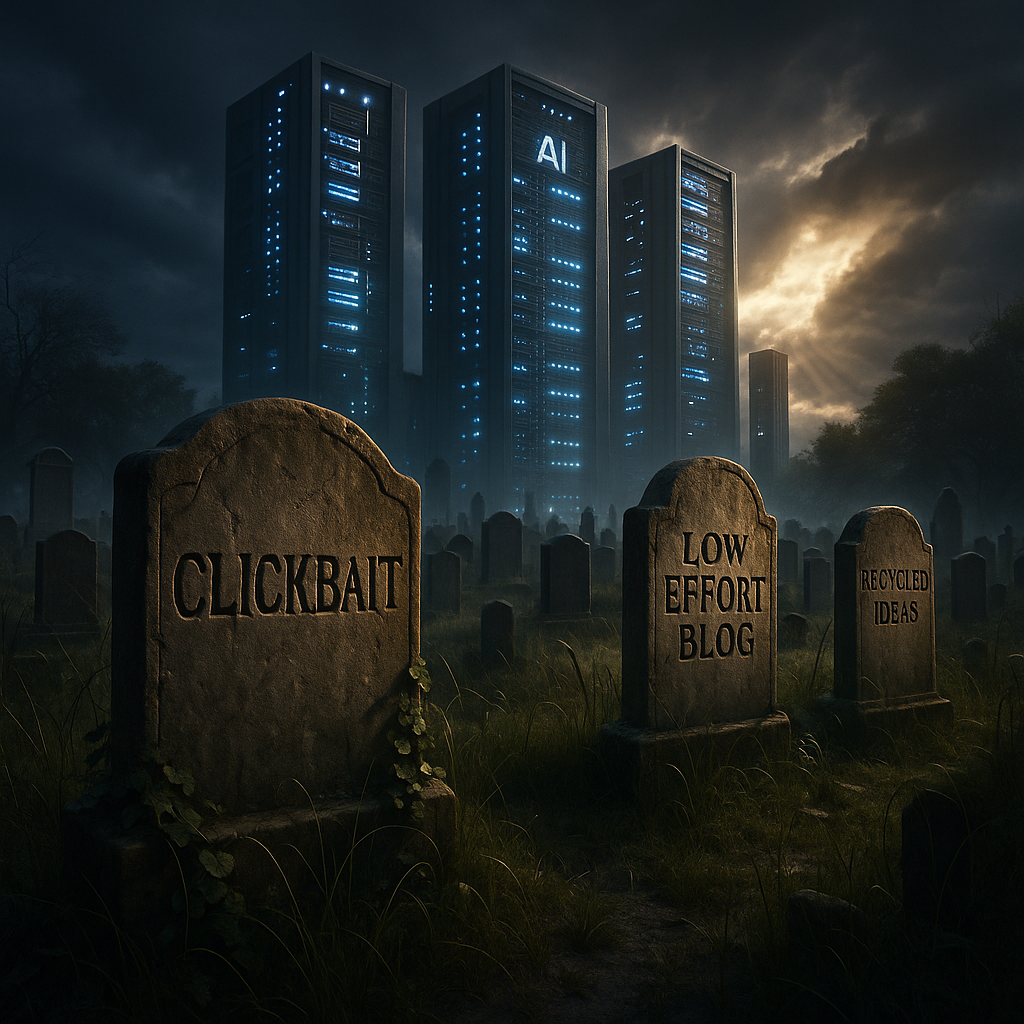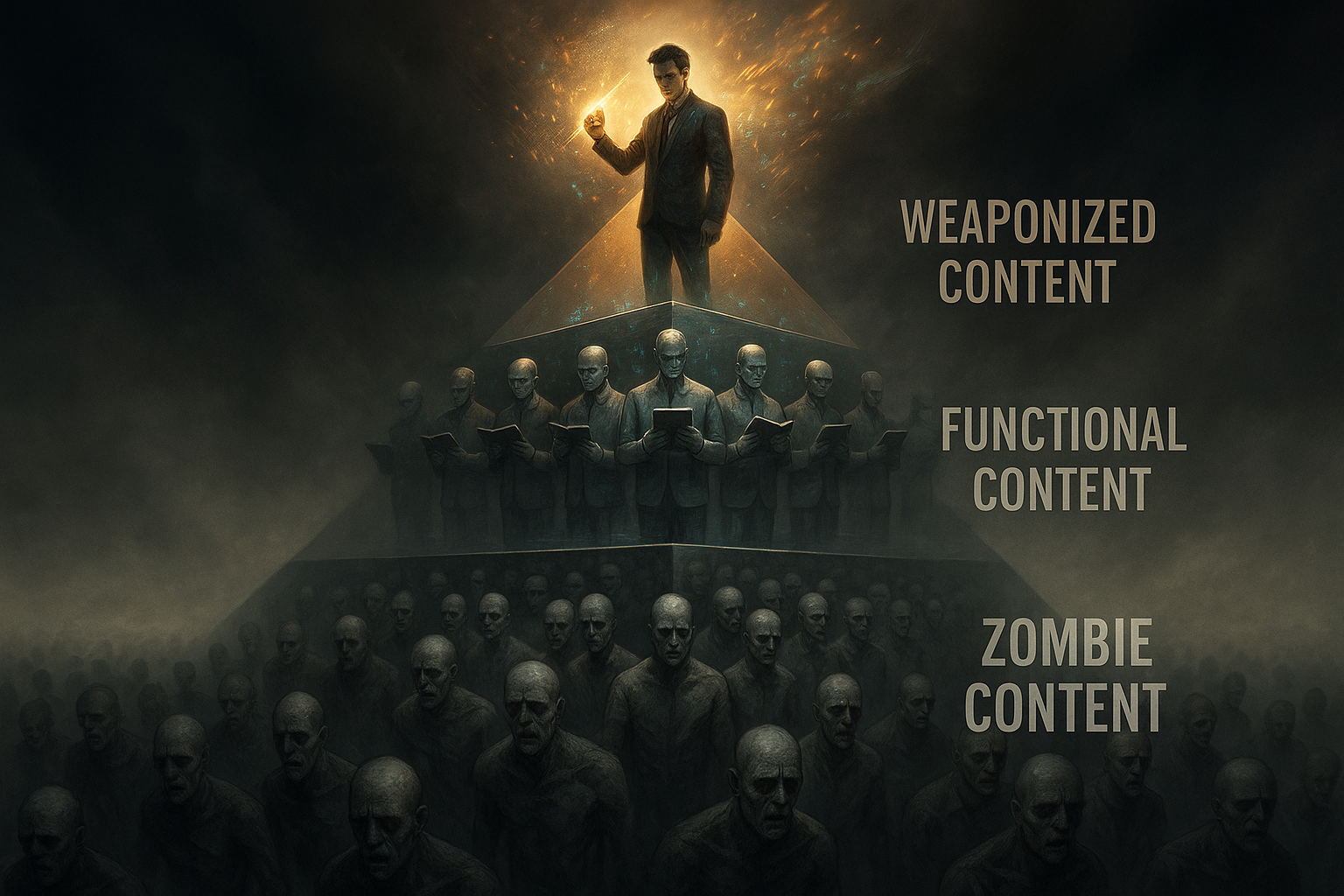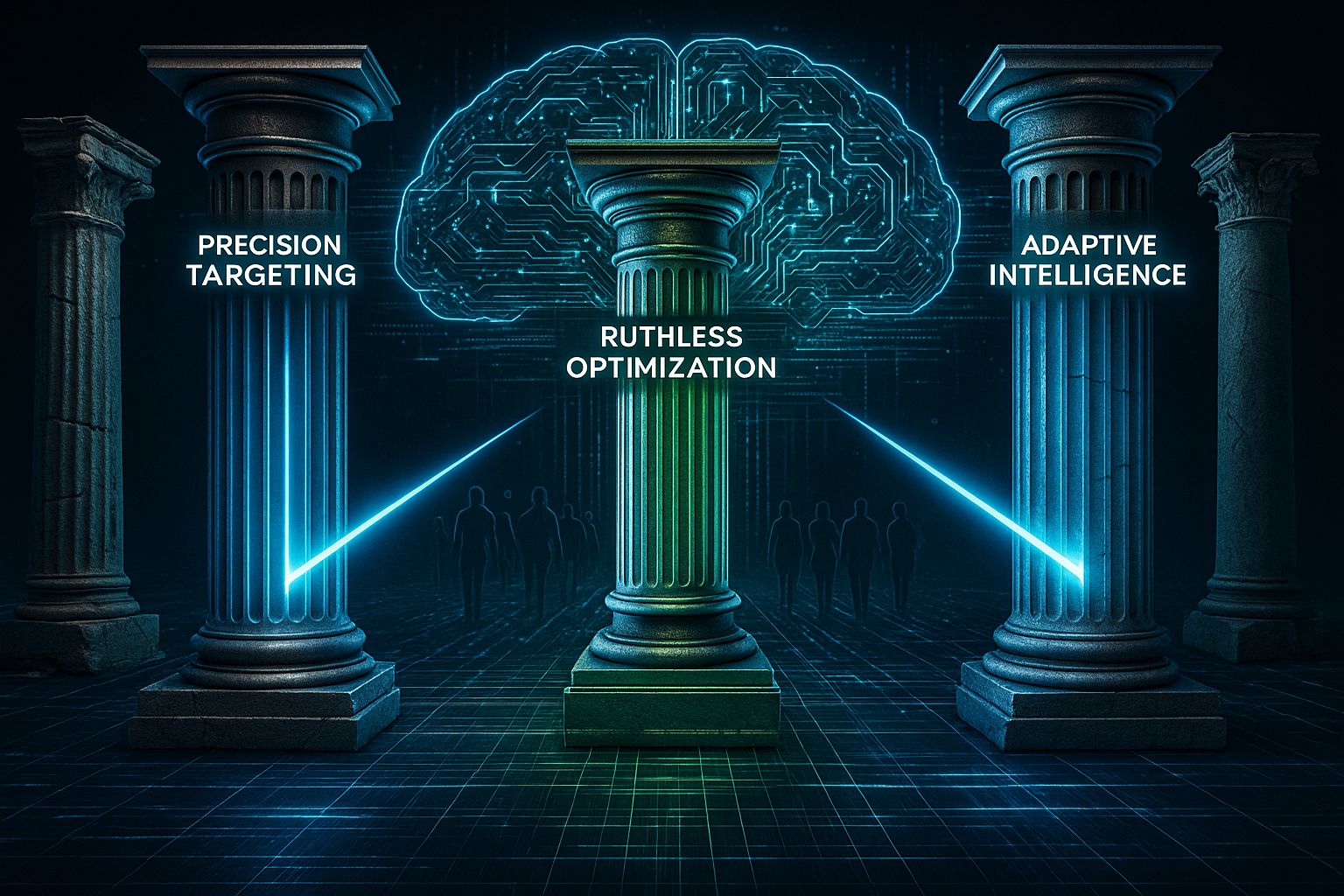
The End of Average Content
The content game just changed, and most of you are still playing by yesterday's rules. While you're pumping out another "10 Tips for Better Productivity" article that reads like every other piece of digital garbage cluttering the internet, the smart players have already moved on. They're not creating content anymore—they're engineering engagement machines that make your best efforts look like a kindergarten finger painting.
Here's the uncomfortable truth nobody wants to admit: Average content is dead. Not dying. Dead. And if you're still churning out the same vanilla, SEO-stuffed drivel that worked in 2015, you're not just behind—you're extinct.
Graveyard of Mediocrity
Let's get specific about what killed average content. According to recent data from Synthesia, 63% of marketers say most content in 2024 comes from generative AI. But here's the kicker—56% claim AI-generated content actually outperforms human content. That's not a typo. The machines aren't just matching human output; they're beating it.
Why? Because most human-created content was already robotic. Cookie-cutter templates. Recycled ideas. The same tired formulas dressed up with different keywords. You were already writing like machines, so when actual machines showed up, they did your job better, faster, and without coffee breaks.
The Stanford AI Index Report 2025 confirms what we already knew: AI bias metrics have improved on standard benchmarks while content quality continues to evolve at breakneck speed. Translation: The excuses for mediocre content just evaporated.
The New Content Hierarchy
Here's how the content landscape actually breaks down now:
The Bottom Tier: Zombie Content This is 80% of what's out there. Blog posts that say nothing. Videos that waste time. Social media posts that exist purely to fill a content calendar. It's not just ineffective—it's actively harmful to your brand. Every piece of zombie content you publish trains your audience to ignore you.
The Middle Tier: Functional Content This serves a purpose but lacks soul. It answers questions. It provides information. It's Wikipedia without the crowd-sourcing. Useful? Sometimes. Memorable? Never. This is where most "good" content lives, and it's not good enough anymore.
The Top Tier: Weaponized Content
This is where Ryne's AI tools come in. Content that doesn't just inform—it transforms. It doesn't just engage—it converts. Every word is calculated. Every sentence serves a purpose. This isn't writing; it's psychological warfare disguised as helpful information.
Humanizer Paradox
Here's where it gets interesting. Everyone's scrambling to make their AI content "more human." They're adding typos. Throwing in colloquialisms. Desperately trying to fool detection systems. They're missing the point entirely.
The goal isn't to make AI content seem human. The goal is to make content that works. Period. Whether it's written by a human, an AI, or a caffeinated hamster on a keyboard doesn't matter if it doesn't drive results.
That's why Ryne's Humanizer tool isn't about deception—it's about optimization. It takes the efficiency of AI and adds the nuance that makes content connect. Not because we're trying to trick anyone, but because connection drives conversion.
Data Doesn't Lie
Let's talk numbers, because feelings don't pay bills:
Research shows that by late 2024, over 54% of long-form LinkedIn posts were likely AI-generated. But here's what they don't tell you—engagement rates on AI-optimized content are crushing traditional content across every metric that matters.
A comprehensive study from MIT found that AI-assisted content creation significantly improves output quality when properly implemented. Not "might improve." Not "could potentially enhance." Significantly improves. Full stop.
The companies still clinging to their "authentic human voice" are watching their engagement rates flatline while AI-powered competitors eat their lunch. Authenticity without effectiveness is just expensive failure.
Three Pillars of Post-Average Content
Pillar 1: Precision Targeting Average content tries to appeal to everyone. Post-average content knows exactly who it's for and speaks directly to them. Every word is chosen not for its poetry but for its impact on a specific neural pathway in your target audience's brain.
Pillar 2: Ruthless Optimization Every headline is tested. Every paragraph is measured. Every call-to-action is calibrated. This isn't creativity—it's science. And science wins.
Pillar 3: Adaptive Intelligence Static content is dead content. Post-average content learns, adapts, and evolves based on real-time engagement data. It's not just smart; it's getting smarter.
The Uncomfortable Truth About Quality
Quality used to mean well-written, thoughtful, carefully crafted content. That definition is obsolete. Quality now means one thing: effectiveness. Does it achieve its objective? Everything else is vanity metrics and creative masturbation.
Your beautifully written think piece that nobody reads? Worthless. That AI-generated listicle that drives 10,000 conversions? That's quality. The market doesn't care about your artistic integrity. It cares about results.
Tools of Domination
Stop using stone-age tools for space-age problems. While you're still wrestling with WordPress and praying to the SEO gods, the winners are using:
- AI content generators that produce in seconds what used to take hours
- Humanization tools that add the perfect amount of personality without sacrificing efficiency
- Engagement predictors that tell you what will work before you publish
- Conversion optimizers that turn readers into customers like clockwork
Ryne's suite of AI tools isn't just another option—it's the nuclear option. The difference between bringing a knife to a gunfight and bringing a tactical nuke.
Psychology of Post-Average
Average content assumes people care about your message. Post-average content knows they don't—and makes them care anyway. It's not about what you want to say; it's about what they need to hear, delivered in a way that bypasses their defenses and lodges directly in their decision-making centers.
This isn't manipulation—it's optimization. Every successful piece of content has always been about psychology. We're just honest about it now.
The Metrics That Matter
Forget vanity metrics. Views don't pay bills. Likes don't close deals. Here's what actually matters:
Conversion Rate: How many readers take the desired action? Time to Conversion: How quickly do they move from awareness to action? Lifetime Value Impact: Does your content create customers or just visitors? Viral Coefficient: Does your content spread itself or die on arrival?
Average content optimizes for the wrong metrics. Post-average content optimizes for the only metric that matters: ROI.
The Death of the Content Calendar
Your meticulously planned content calendar is a monument to inefficiency. While you're scheduling posts three months out, the market has already moved three times. Post-average content is responsive, not planned. It reacts to trends in real-time, not quarterly planning sessions.
The winners aren't following editorial calendars—they're following the data. They publish when the moment is right, not when the calendar says so.
The Rise of Hybrid Intelligence
The future isn't human vs. AI. It's human with AI. The most effective content creators aren't choosing sides—they're combining forces. Human creativity directed by AI insights. Machine efficiency guided by human intuition.
This is where tools like Ryne's Humanizer become weapons of mass persuasion. They don't replace human creativity; they amplify it. They don't eliminate the human touch; they perfect it.
New Rules of Engagement
Rule 1: If it doesn't convert, it doesn't count. Rule 2: Speed beats perfection every time. Rule 3: Data trumps opinion, always. Rule 4: Test everything, assume nothing. Rule 5: What worked yesterday is already obsolete.
These aren't suggestions. They're survival requirements. Ignore them at your own peril.
The Content Apocalypse Is Here
We're not approaching a content crisis—we're in it. The internet is drowning in mediocrity. Search engines are choking on garbage. Social media feeds are graveyards of failed engagement attempts.
But this isn't a disaster—it's an opportunity. While everyone else is contributing to the noise, you can cut through it. While they're playing the old game, you can write new rules.
The Choice Is Binary
You have two options:
Option 1: Keep doing what you're doing. Keep producing average content. Keep watching your engagement rates decline. Keep losing to competitors who get it. Keep telling yourself that "authentic human content" will make a comeback while your business slowly dies.
Option 2: Embrace the new reality. Use the tools that work. Create content that converts. Stop caring about what content "should be" and start caring about what works.
There is no Option 3.
Bottom Line
Average content is dead because average anything is dead. In a world where AI can produce infinite content instantly, only the exceptional survives. But exceptional doesn't mean what it used to mean. It doesn't mean beautiful prose or clever wordplay. It means effective. It means converting. It means winning.
The tools exist. Ryne's AI platform has already weaponized them. The question isn't whether you'll adapt—it's whether you'll adapt fast enough.
Stop creating content. Start engineering outcomes. Stop writing for humans. Start programming responses. Stop hoping for engagement. Start guaranteeing it.
The age of average is over. The age of optimized has begun. You're either obsolete or you're evolving. Choose wisely. Choose quickly. Choose now.
Because while you're reading this, your competitors are already implementing it. And in the new content economy, second place is just first loser.
Welcome to the end of average content. Welcome to the beginning of everything else.

Why is my essay detected as AI?
Here's the truth nobody wants to tell you: AI detectors are broken. They're flagging your legitimate work as machine-generated because these tools are fundamentally flawed, biased, and operating on guesswork. You wrote every word yourself, yet some algorithm decided you're a cheater. The system is rigged against you—and we're about to expose exactly wh

The $200K Degree Scam vs The Free AI That Actually Educates
While universities are still peddling the same overpriced education model from 1950, charging you $200,000 for knowledge you could get from YouTube, there's a revolution happening right under their noses. And they're terrified. Here's what they don't want you to know: The entire higher education system is a bloated, antiquated machine designed to extract maximum cash while delivering minimum value. Meanwhile, AI is doing what universities promised but never delivered—actual personalized education that works.

